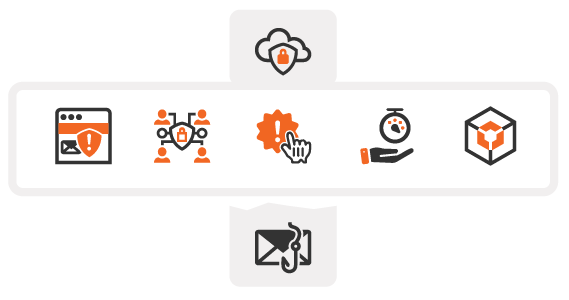An attack surface is the sum of all the different attack vectors a threat actor can exploit to enter and harm a hardware and software environment. In this blog post, learn how to significantly reduce the attack surface of your cloud email environment with comprehensive, cloud-native email security tools.
Email security has existed for decades. However, in 2019 almost half (49.8%) of information security professionals reported email threats and malicious messages reached their end users’ inboxes every week despite their investments in traditional email security technology. The FBI also reported that in 2019 that business email compromise (BEC) and email account compromise (EAC) complaints accounted for more than $1.7 billion in losses, increasing by 160% in just two years.
How can email security solutions protect users from threats targeting your organization? The answer lies in the email security stack—advanced attacks require comprehensive email security solutions to reduce the attack surface and protect users, from threat detection through incident response and remediation.
What’s changed?
Legacy secure email gateway (SEG) solutions still perform traditional tasks well, like preventing traditional email attacks and providing continuity. But these legacy SEGs struggle to identify more advanced threats, like business email compromise, impersonation, brand lookalikes, and advanced business service spoofing attacks. These significant technical and operational challenges cause security teams to spend hours removing threats from user inboxes in complicated admin consoles.
Unlike legacy SEG solutions, adopting a cloud-native approach allows organizations to master the top 5 capabilities required to significantly reduce the attack surface of their email environment:

- Advanced Phishing / Impersonation Attack Detection and Protection
No email security solution prevents 100% of today’s advanced threats. In order to truly reduce the email attack surface, it is imperative to deploy solutions with dynamic threat detection and protection that identifies malicious links and advanced phishing attacks like executive impersonations or account takeovers rapidly and accurately. - Dynamic & Contextual Bannering
Organizations looking to reduce risk in their email environments should look beyond security awareness training to lower user engagement with risky email. Organizations should also empower employees to become the first line of defense. Look for email security solutions that provide clear, context-specific warnings before users interact with a potential threat. - Link Protection
Traditional blocking solutions do not go far enough in protecting email environments. Some of the greatest dangers to an organization’s email environment aren’t known malicious links—they’re safe links that have been weaponized after delivery. Organizations should look to solutions that go beyond comparison to known malicious links and provide:- Contextual warning about security risks
- Realtime alerting to both admins and email users of potential threats
- Real-time link analysis
- A warning page for suspicious links with browser-isolated preview
- Compound Search & Rapid Remediation
No email security tool can block 100% of threats. Despite best efforts, there will always be a need for email threat removal—yet today’s security professionals often have to rely on time-consuming scripting or a rudimentary and manual search and removal process. Unfortunately, every minute spent on incident response is one minute closer to a click and a potential breach. Knowing this, organizations must look for solutions that make it easy to find and bulk remove threats from user inboxes in seconds, not minutes or hours. - Relationship Analysis
Many tools rely on basic analysis between sender and recipient – i.e. “Has there ever been email communication before?” However, in order to maximize the value of relationship analytics, an organization will have to consider other factors. Are these communications both bidirectional and recent? Are they strong or weak? Does this sender have any relationship with others in the organization? Each of these data points helps refine the overall analysis, identify inconsistencies, and reduce false positives. These deep relationship analytics allow organizations to gain more insight into the threat landscape of their environment.
In order to effectively reduce the attack surface and minimize risk exposure, organizations must turn away from the binary threat-blocking mindset to an approach that considers email security a multifaceted risk management function. API-based email security solutions provide the advanced analysis, threat detection, protection and fast incident response needed to protect users at all points in the email security lifecycle.
GreatHorn’s cloud-native, email security platform protects Microsoft Office 365 and Google G Suite customers from both malware threats and sophisticated social engineering attempts. In one Fortune 500 company, we identified more than 50,000 threats (business email compromise, credential theft, malicious links, malicious URLs, and more) that were missed by both traditional secure email gateways and Microsoft ATP.





